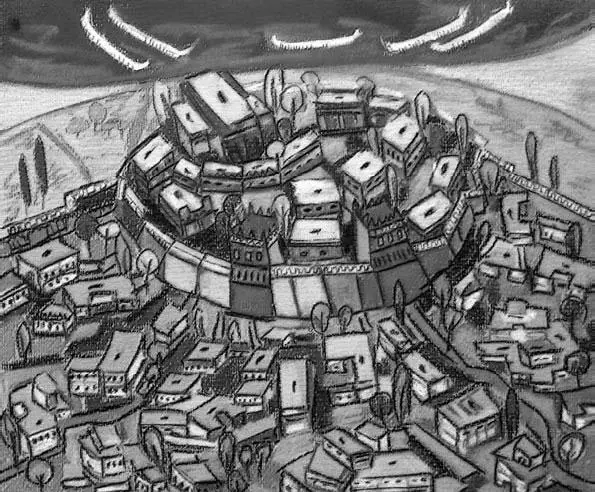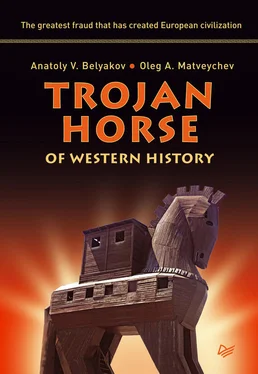According to the legend, Ilion was founded by Ilus, son of Tros. Then the power was overtaken by Ilion’s son Laomedon. During its times, Troy achieved might and established control over Asia Minor, Propontis (the Sea of Marmara) and the straits. Laomedon erected a “city on the top of the hill”, the walls of which were built by Poseidon, who ended up a slave to Zeus (by Zeus’ will) together with Apollo, ordered to pasture Zeus’ oxen. For their assiduous work, Laomedon promised to pay the gods, but changed his mind and, in the end, just expelled them from the country, threatening to cut their ears off (Ilus. XXI, 440–458). Then Poseidon sent a sea monster to Ilion to devour all the people. It was when Heracles came in and killed the monster, getting into the monster’s belly and hacking all its entrails. For this feat, Laomedon promised him magic horses but once again failed to keep his promise. Nothing to be done, Heracles had to destroy the city, to kill Laomedon and to shoot all his heirs to death by bow and arrow, and to give the king’s daughter Hesion [27] Etymologically the name Hesion associated with the word Asia. Hesion – asiyka, a resident of Anatolia. (L.A. Gindin, V.L. Tsymbursky, Homer and the history of the oriental Mediterranean (Мoscow: Vostochnaya Literature, 1996); p. 53).
to his friend Telamon. At the same time, Hesion was allowed to release one of the captives. She chose her younger brother Podarces and paid for him with her headscarf. Since then, Podarces was called Priam, meaning “redeemed”. [28] When she became the wife of Telamon, Hesion bore Teucer, who thus became the half-brother of Ajax Telamonid.
Thus, the legend obviously referred to the times of Troy 6, and the earthquake that destroyed the city was interpreted as anger of Heracles.

Fig. 15.That’s what Troy 6 looks like to our contemporaries. (Image © Nika Tya-Sen.)
Who were the founders of Troy 6, so noticeably different from the cities of previous periods? Blegen was sure that they were Greeks; however, he could not know for sure how they departed for new lands. He wrote, “They did not manage to define whether they roamed from the North to the shore of the Aegean Sea, or sailed from the South of Russia across the they arrived in Greece by sea from the West or the East. There are no hints left by either ceramics, artefacts, or horse bones”. [29] Carl Blegen, Troy and the Trojans.

Fig. 16.The fortification wall and the East gate of Troy 6 (15th – 13th century B.C.).
Troy 7 referred to the period 1300–1100 B.C. The Trojan War is considered to have taken place during that period. There are some calculations based on different methods, but most of them put this era at between 1220 and 1180 B.C.
The ancient writers could only estimate the dates of the Trojan War, according to the approximate number of generations up to the first Olympic Games, epical tradition, etc. And they arrived at different results, ranging from the 14th to 12th centuries B.C. There were other methods, too, including the study of archaeological artefacts, epigraphy, etc.
The unique method was applied in 2008 by Marcelo Magnasco, Professor of Physics and Mathematics of the American Rockefeller University, and Constantino Baikouzis, astronomer from the Argentina’s La-Plata Observatory. [30] C. Baikouzis, M.O. Magnasco, “Is an eclipse described in the Odyssey?” Proceedings of the National Academy of Sciences, June 24 (2008). URL: http://www.pnas.org/content/105/26/8823.full
They took note that according to Homer when Odysseus was beating the grooms seeking to marry his wife Penelope,
…the sun has perished out of heaven and an evil mist hovers over all
Odyssey. XX. 356–357
and they decided that this text pertained to a solar eclipse. The dates of solar eclipses, both in the past and future, can be easily calculated. Having compared these dates with other astronomical data provided in the text, scientists concluded that King Odysseus returned to Ithaca on April 16th, 1178 B.C. According to Homer, Odysseus’ wandering after the Trojan War took about 10 years. Thus, according to Magnasco and Baikouzis, the Trojan War could have been limited with chronological frame of 1188 and 1198 B.C.
After the earthquake, the city was built up again. There were no traces of people in the ruins of Troy 6, and Blegen concluded that the population survived and immediately after the earthquake ended they returned to the city and started to restore their houses. In due course, the city became more populated, as the streets became more compact and the houses became smaller. However, traces of imported goods and wealth vanished. In general, Troy 7 was nothing of the majestic city “rich in gold” described by Homer.
The city that belonged to the first phase of Troy 7, deemed as 7а (1300–1260 B.C.), was destroyed by fire. The territory of the settlement was once again covered with loads of stones, mudbricks and various wastes, burnt-down and half-burnt-down. Fragments of human bodies found in this layer point indicated that citizens died through violence. Thus, according to Blegen, Troy 7a was destroyed due to the city having been captured and citizens dying. “The crowding of numerous small houses anywhere a free place could be found points to the fact that the fortress walls were protecting many more citizens than before. Numerous uncountable capacious vessels for food and water standing on floors of virtually every house and room indicate the need to store as much food and water as possible in case of emergency. What else could that emergency be than the enemy siege?” [31] Carl Blegen, Troy and the Trojans .
Upon analyzing the Mycenaean pottery discovered in the cultural layer of the burnt city and comparing it to the chronology of ceramics of Arne Furumark, [32] A. Furumark, Mycenaean Pottery I: Analysis and Classification (Stockholm, 1941).
Blegen realized that most of these samples referred to type 3 B dated first half of the 13[[th]] century B.C. Samples classified as the earlier type 3A is sparsely encountered in this layer, and there are no items of the later type 3C. On this basis, Blegen concluded that Troy 7a had been destroyed in approximately 1260, two generations earlier than the Mycenaean civilization declined. “Most of large Mycenaean cities in continental Greece (perhaps, but the cities of Attica) were destroyed in the end of the era when Mycenaean pottery classified III B was produced… Approximately by 1200 B.C., might of Mycenae waved; large cities, the population of which was referred in the Catalogue of Ships as the core of Agamemnon’s troops marching against Troy, were in ruins, and the survivors faced an even more difficult struggle for survival. The period, when type 3C pottery was used every day was characterized by people’s impoverishment and culture level decline, and only memories of Mycenae’s former glory remained. The Mycenaean kings and princes couldn’t unite their forces and leave to capture other lands. That was only possible much before that, when the Mycenaean civilization was at the height of its political, economic and military power, when splendid emperor’s palaces hospitably met dear guests in their entire splendor. The fortress was seized and burnt before the mid-13[[th]] century B.C., which was when the type 3B Mycenaean pottery was only introduced in Troy 7a being prosperous yet, and the type 2A pottery was doling out the seat.
Читать дальше













